MGMT 20135 Article Review: Critical Thinking and Culture
VerifiedAdded on 2023/06/09
|8
|2004
|367
Report
AI Summary
This report is an article review that analyzes the research article by Lun, Fischer & Ward (2010), focusing on cultural differences in critical thinking. The review begins with an introduction outlining the research background, which highlights the influence of critical thinking on student learning in the information age. The discussion section delves into the research problem, exploring whether Asian students exhibit different critical thinking patterns compared to their Western counterparts, and examines the impact of classroom environments and language proficiency on cognitive skills. The review addresses the research methodology, including a survey conducted at a New Zealand-based university using the Halpern's Critical Thinking Assessment and Watson-Glaser tool to assess the effects of language proficiency. The findings indicate that European and New Zealand students performed better on critical thinking tests, and there's a positive correlation between dialectical self-concept and performance for Asian students. The conclusion summarizes the major outcomes, emphasizing the lesser emphasis on critical output in Asian universities compared to New Zealand universities, and limitations of the research. The report also includes a comprehensive reference list in APA style.

Running head: CRITICAL THINKING
CRITICAL THINKING
Student’s Name
University Name
Author’s Name
CRITICAL THINKING
Student’s Name
University Name
Author’s Name
Paraphrase This Document
Need a fresh take? Get an instant paraphrase of this document with our AI Paraphraser
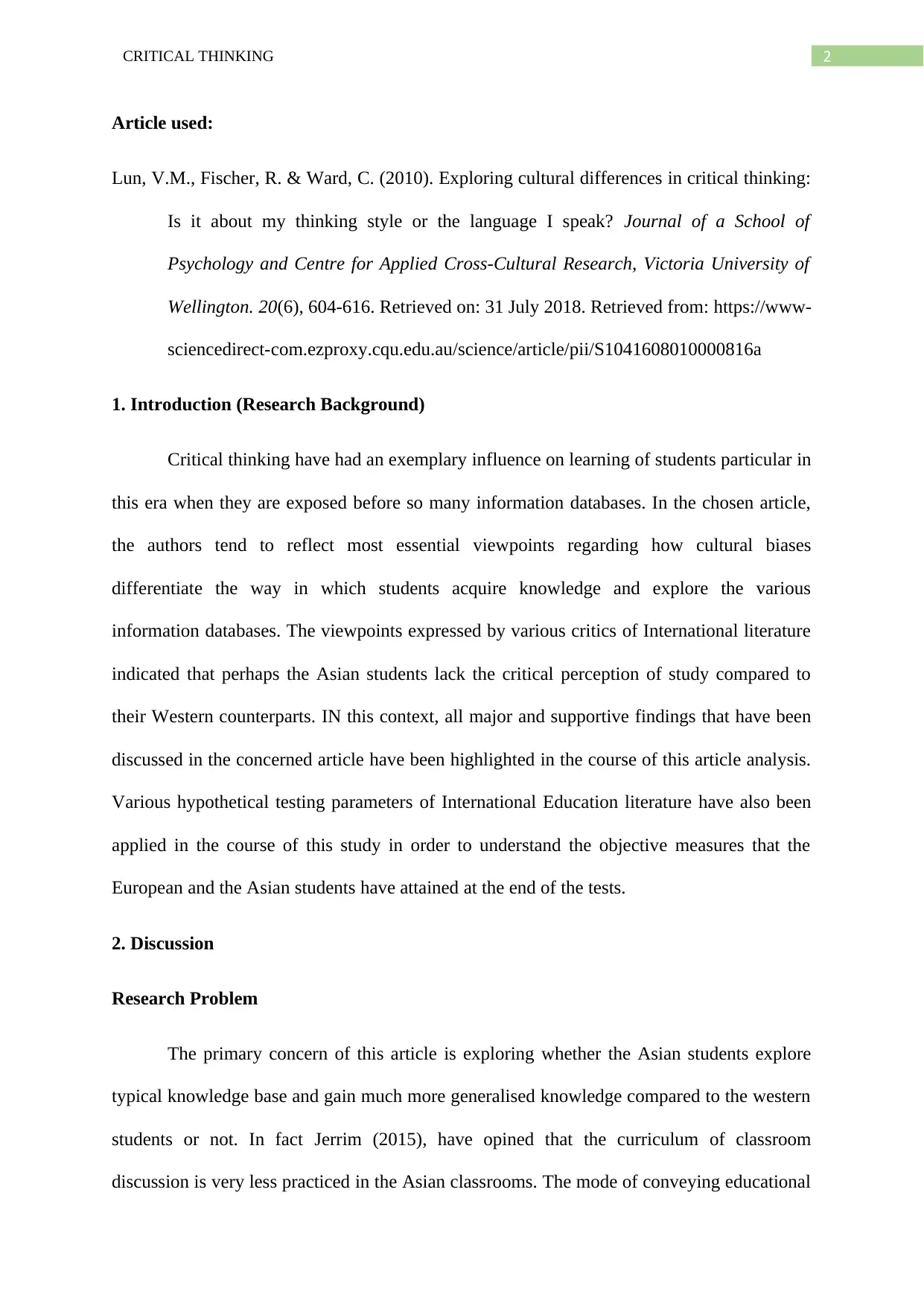
2CRITICAL THINKING
Article used:
Lun, V.M., Fischer, R. & Ward, C. (2010). Exploring cultural differences in critical thinking:
Is it about my thinking style or the language I speak? Journal of a School of
Psychology and Centre for Applied Cross-Cultural Research, Victoria University of
Wellington. 20(6), 604-616. Retrieved on: 31 July 2018. Retrieved from: https://www-
sciencedirect-com.ezproxy.cqu.edu.au/science/article/pii/S1041608010000816a
1. Introduction (Research Background)
Critical thinking have had an exemplary influence on learning of students particular in
this era when they are exposed before so many information databases. In the chosen article,
the authors tend to reflect most essential viewpoints regarding how cultural biases
differentiate the way in which students acquire knowledge and explore the various
information databases. The viewpoints expressed by various critics of International literature
indicated that perhaps the Asian students lack the critical perception of study compared to
their Western counterparts. IN this context, all major and supportive findings that have been
discussed in the concerned article have been highlighted in the course of this article analysis.
Various hypothetical testing parameters of International Education literature have also been
applied in the course of this study in order to understand the objective measures that the
European and the Asian students have attained at the end of the tests.
2. Discussion
Research Problem
The primary concern of this article is exploring whether the Asian students explore
typical knowledge base and gain much more generalised knowledge compared to the western
students or not. In fact Jerrim (2015), have opined that the curriculum of classroom
discussion is very less practiced in the Asian classrooms. The mode of conveying educational
Article used:
Lun, V.M., Fischer, R. & Ward, C. (2010). Exploring cultural differences in critical thinking:
Is it about my thinking style or the language I speak? Journal of a School of
Psychology and Centre for Applied Cross-Cultural Research, Victoria University of
Wellington. 20(6), 604-616. Retrieved on: 31 July 2018. Retrieved from: https://www-
sciencedirect-com.ezproxy.cqu.edu.au/science/article/pii/S1041608010000816a
1. Introduction (Research Background)
Critical thinking have had an exemplary influence on learning of students particular in
this era when they are exposed before so many information databases. In the chosen article,
the authors tend to reflect most essential viewpoints regarding how cultural biases
differentiate the way in which students acquire knowledge and explore the various
information databases. The viewpoints expressed by various critics of International literature
indicated that perhaps the Asian students lack the critical perception of study compared to
their Western counterparts. IN this context, all major and supportive findings that have been
discussed in the concerned article have been highlighted in the course of this article analysis.
Various hypothetical testing parameters of International Education literature have also been
applied in the course of this study in order to understand the objective measures that the
European and the Asian students have attained at the end of the tests.
2. Discussion
Research Problem
The primary concern of this article is exploring whether the Asian students explore
typical knowledge base and gain much more generalised knowledge compared to the western
students or not. In fact Jerrim (2015), have opined that the curriculum of classroom
discussion is very less practiced in the Asian classrooms. The mode of conveying educational
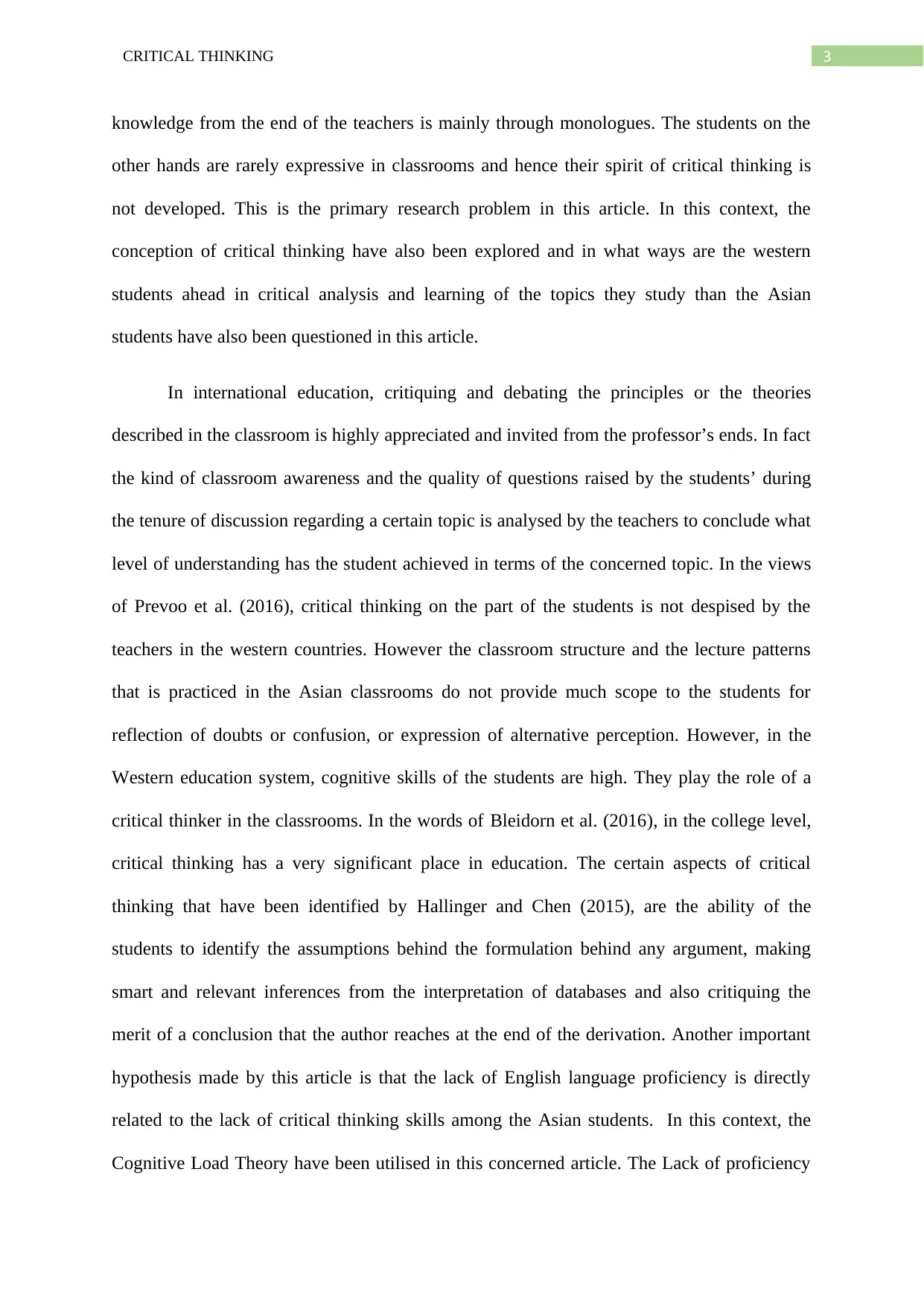
3CRITICAL THINKING
knowledge from the end of the teachers is mainly through monologues. The students on the
other hands are rarely expressive in classrooms and hence their spirit of critical thinking is
not developed. This is the primary research problem in this article. In this context, the
conception of critical thinking have also been explored and in what ways are the western
students ahead in critical analysis and learning of the topics they study than the Asian
students have also been questioned in this article.
In international education, critiquing and debating the principles or the theories
described in the classroom is highly appreciated and invited from the professor’s ends. In fact
the kind of classroom awareness and the quality of questions raised by the students’ during
the tenure of discussion regarding a certain topic is analysed by the teachers to conclude what
level of understanding has the student achieved in terms of the concerned topic. In the views
of Prevoo et al. (2016), critical thinking on the part of the students is not despised by the
teachers in the western countries. However the classroom structure and the lecture patterns
that is practiced in the Asian classrooms do not provide much scope to the students for
reflection of doubts or confusion, or expression of alternative perception. However, in the
Western education system, cognitive skills of the students are high. They play the role of a
critical thinker in the classrooms. In the words of Bleidorn et al. (2016), in the college level,
critical thinking has a very significant place in education. The certain aspects of critical
thinking that have been identified by Hallinger and Chen (2015), are the ability of the
students to identify the assumptions behind the formulation behind any argument, making
smart and relevant inferences from the interpretation of databases and also critiquing the
merit of a conclusion that the author reaches at the end of the derivation. Another important
hypothesis made by this article is that the lack of English language proficiency is directly
related to the lack of critical thinking skills among the Asian students. In this context, the
Cognitive Load Theory have been utilised in this concerned article. The Lack of proficiency
knowledge from the end of the teachers is mainly through monologues. The students on the
other hands are rarely expressive in classrooms and hence their spirit of critical thinking is
not developed. This is the primary research problem in this article. In this context, the
conception of critical thinking have also been explored and in what ways are the western
students ahead in critical analysis and learning of the topics they study than the Asian
students have also been questioned in this article.
In international education, critiquing and debating the principles or the theories
described in the classroom is highly appreciated and invited from the professor’s ends. In fact
the kind of classroom awareness and the quality of questions raised by the students’ during
the tenure of discussion regarding a certain topic is analysed by the teachers to conclude what
level of understanding has the student achieved in terms of the concerned topic. In the views
of Prevoo et al. (2016), critical thinking on the part of the students is not despised by the
teachers in the western countries. However the classroom structure and the lecture patterns
that is practiced in the Asian classrooms do not provide much scope to the students for
reflection of doubts or confusion, or expression of alternative perception. However, in the
Western education system, cognitive skills of the students are high. They play the role of a
critical thinker in the classrooms. In the words of Bleidorn et al. (2016), in the college level,
critical thinking has a very significant place in education. The certain aspects of critical
thinking that have been identified by Hallinger and Chen (2015), are the ability of the
students to identify the assumptions behind the formulation behind any argument, making
smart and relevant inferences from the interpretation of databases and also critiquing the
merit of a conclusion that the author reaches at the end of the derivation. Another important
hypothesis made by this article is that the lack of English language proficiency is directly
related to the lack of critical thinking skills among the Asian students. In this context, the
Cognitive Load Theory have been utilised in this concerned article. The Lack of proficiency
⊘ This is a preview!⊘
Do you want full access?
Subscribe today to unlock all pages.

Trusted by 1+ million students worldwide
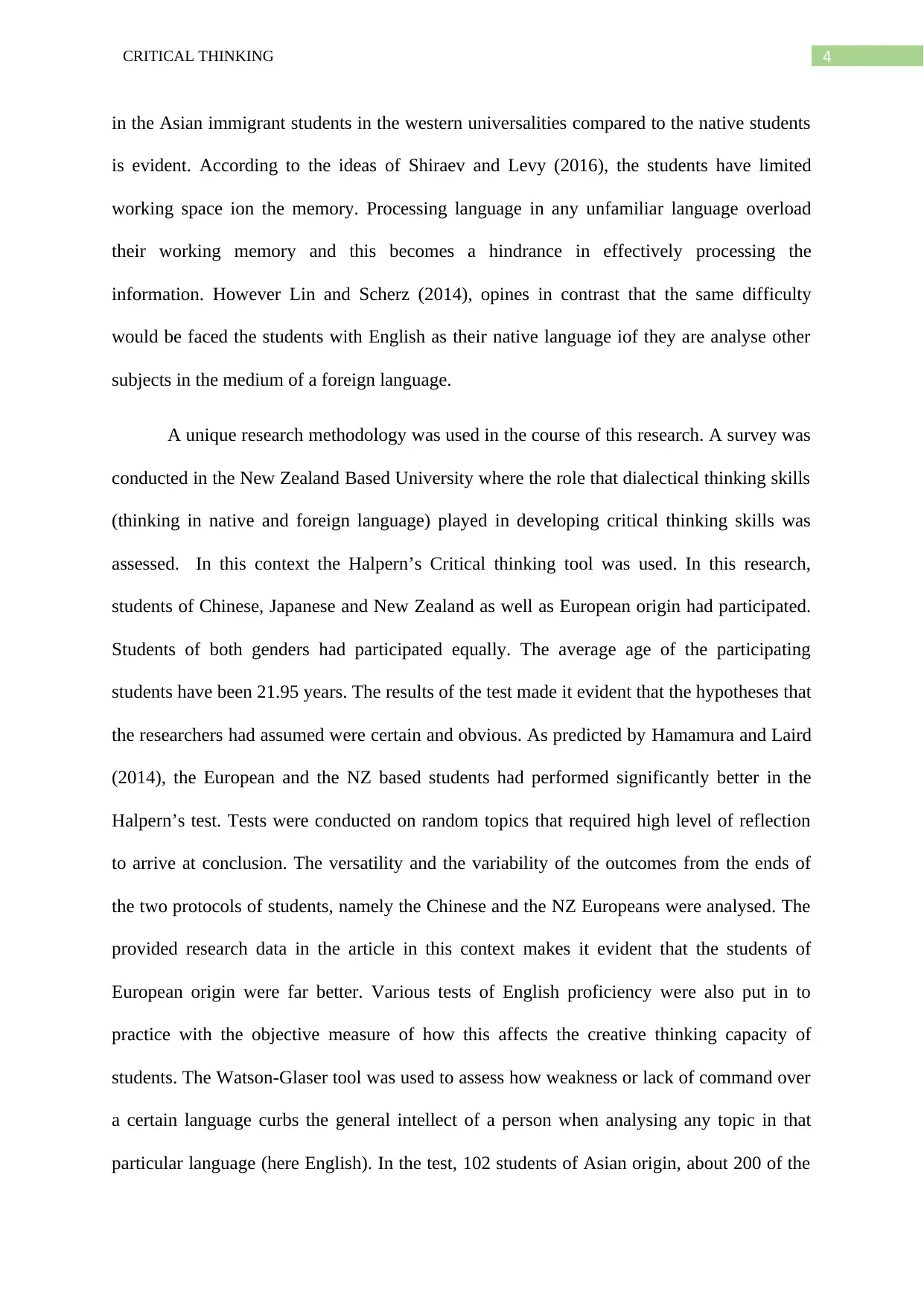
4CRITICAL THINKING
in the Asian immigrant students in the western universalities compared to the native students
is evident. According to the ideas of Shiraev and Levy (2016), the students have limited
working space ion the memory. Processing language in any unfamiliar language overload
their working memory and this becomes a hindrance in effectively processing the
information. However Lin and Scherz (2014), opines in contrast that the same difficulty
would be faced the students with English as their native language iof they are analyse other
subjects in the medium of a foreign language.
A unique research methodology was used in the course of this research. A survey was
conducted in the New Zealand Based University where the role that dialectical thinking skills
(thinking in native and foreign language) played in developing critical thinking skills was
assessed. In this context the Halpern’s Critical thinking tool was used. In this research,
students of Chinese, Japanese and New Zealand as well as European origin had participated.
Students of both genders had participated equally. The average age of the participating
students have been 21.95 years. The results of the test made it evident that the hypotheses that
the researchers had assumed were certain and obvious. As predicted by Hamamura and Laird
(2014), the European and the NZ based students had performed significantly better in the
Halpern’s test. Tests were conducted on random topics that required high level of reflection
to arrive at conclusion. The versatility and the variability of the outcomes from the ends of
the two protocols of students, namely the Chinese and the NZ Europeans were analysed. The
provided research data in the article in this context makes it evident that the students of
European origin were far better. Various tests of English proficiency were also put in to
practice with the objective measure of how this affects the creative thinking capacity of
students. The Watson-Glaser tool was used to assess how weakness or lack of command over
a certain language curbs the general intellect of a person when analysing any topic in that
particular language (here English). In the test, 102 students of Asian origin, about 200 of the
in the Asian immigrant students in the western universalities compared to the native students
is evident. According to the ideas of Shiraev and Levy (2016), the students have limited
working space ion the memory. Processing language in any unfamiliar language overload
their working memory and this becomes a hindrance in effectively processing the
information. However Lin and Scherz (2014), opines in contrast that the same difficulty
would be faced the students with English as their native language iof they are analyse other
subjects in the medium of a foreign language.
A unique research methodology was used in the course of this research. A survey was
conducted in the New Zealand Based University where the role that dialectical thinking skills
(thinking in native and foreign language) played in developing critical thinking skills was
assessed. In this context the Halpern’s Critical thinking tool was used. In this research,
students of Chinese, Japanese and New Zealand as well as European origin had participated.
Students of both genders had participated equally. The average age of the participating
students have been 21.95 years. The results of the test made it evident that the hypotheses that
the researchers had assumed were certain and obvious. As predicted by Hamamura and Laird
(2014), the European and the NZ based students had performed significantly better in the
Halpern’s test. Tests were conducted on random topics that required high level of reflection
to arrive at conclusion. The versatility and the variability of the outcomes from the ends of
the two protocols of students, namely the Chinese and the NZ Europeans were analysed. The
provided research data in the article in this context makes it evident that the students of
European origin were far better. Various tests of English proficiency were also put in to
practice with the objective measure of how this affects the creative thinking capacity of
students. The Watson-Glaser tool was used to assess how weakness or lack of command over
a certain language curbs the general intellect of a person when analysing any topic in that
particular language (here English). In the test, 102 students of Asian origin, about 200 of the
Paraphrase This Document
Need a fresh take? Get an instant paraphrase of this document with our AI Paraphraser
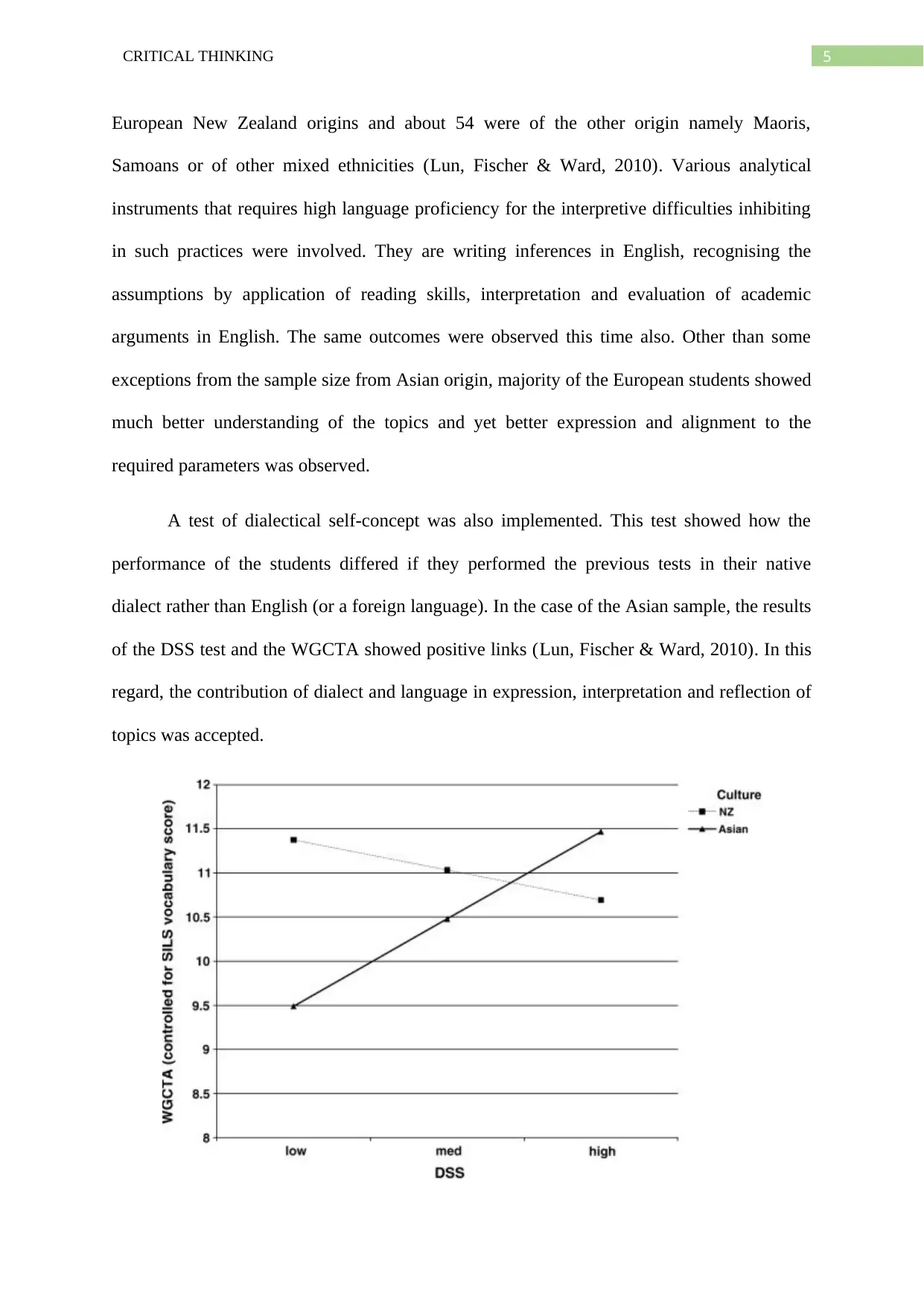
5CRITICAL THINKING
European New Zealand origins and about 54 were of the other origin namely Maoris,
Samoans or of other mixed ethnicities (Lun, Fischer & Ward, 2010). Various analytical
instruments that requires high language proficiency for the interpretive difficulties inhibiting
in such practices were involved. They are writing inferences in English, recognising the
assumptions by application of reading skills, interpretation and evaluation of academic
arguments in English. The same outcomes were observed this time also. Other than some
exceptions from the sample size from Asian origin, majority of the European students showed
much better understanding of the topics and yet better expression and alignment to the
required parameters was observed.
A test of dialectical self-concept was also implemented. This test showed how the
performance of the students differed if they performed the previous tests in their native
dialect rather than English (or a foreign language). In the case of the Asian sample, the results
of the DSS test and the WGCTA showed positive links (Lun, Fischer & Ward, 2010). In this
regard, the contribution of dialect and language in expression, interpretation and reflection of
topics was accepted.
European New Zealand origins and about 54 were of the other origin namely Maoris,
Samoans or of other mixed ethnicities (Lun, Fischer & Ward, 2010). Various analytical
instruments that requires high language proficiency for the interpretive difficulties inhibiting
in such practices were involved. They are writing inferences in English, recognising the
assumptions by application of reading skills, interpretation and evaluation of academic
arguments in English. The same outcomes were observed this time also. Other than some
exceptions from the sample size from Asian origin, majority of the European students showed
much better understanding of the topics and yet better expression and alignment to the
required parameters was observed.
A test of dialectical self-concept was also implemented. This test showed how the
performance of the students differed if they performed the previous tests in their native
dialect rather than English (or a foreign language). In the case of the Asian sample, the results
of the DSS test and the WGCTA showed positive links (Lun, Fischer & Ward, 2010). In this
regard, the contribution of dialect and language in expression, interpretation and reflection of
topics was accepted.
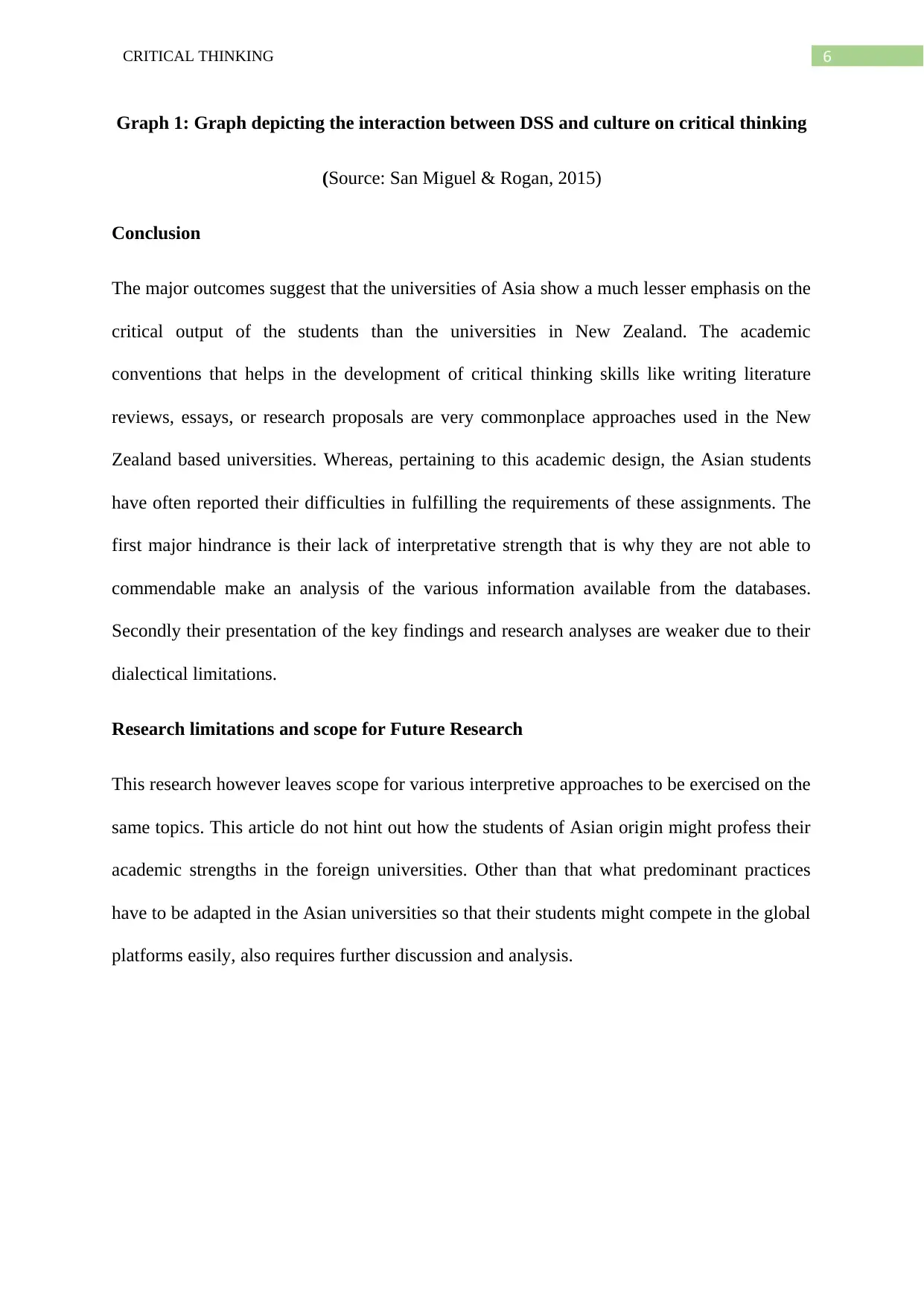
6CRITICAL THINKING
Graph 1: Graph depicting the interaction between DSS and culture on critical thinking
(Source: San Miguel & Rogan, 2015)
Conclusion
The major outcomes suggest that the universities of Asia show a much lesser emphasis on the
critical output of the students than the universities in New Zealand. The academic
conventions that helps in the development of critical thinking skills like writing literature
reviews, essays, or research proposals are very commonplace approaches used in the New
Zealand based universities. Whereas, pertaining to this academic design, the Asian students
have often reported their difficulties in fulfilling the requirements of these assignments. The
first major hindrance is their lack of interpretative strength that is why they are not able to
commendable make an analysis of the various information available from the databases.
Secondly their presentation of the key findings and research analyses are weaker due to their
dialectical limitations.
Research limitations and scope for Future Research
This research however leaves scope for various interpretive approaches to be exercised on the
same topics. This article do not hint out how the students of Asian origin might profess their
academic strengths in the foreign universities. Other than that what predominant practices
have to be adapted in the Asian universities so that their students might compete in the global
platforms easily, also requires further discussion and analysis.
Graph 1: Graph depicting the interaction between DSS and culture on critical thinking
(Source: San Miguel & Rogan, 2015)
Conclusion
The major outcomes suggest that the universities of Asia show a much lesser emphasis on the
critical output of the students than the universities in New Zealand. The academic
conventions that helps in the development of critical thinking skills like writing literature
reviews, essays, or research proposals are very commonplace approaches used in the New
Zealand based universities. Whereas, pertaining to this academic design, the Asian students
have often reported their difficulties in fulfilling the requirements of these assignments. The
first major hindrance is their lack of interpretative strength that is why they are not able to
commendable make an analysis of the various information available from the databases.
Secondly their presentation of the key findings and research analyses are weaker due to their
dialectical limitations.
Research limitations and scope for Future Research
This research however leaves scope for various interpretive approaches to be exercised on the
same topics. This article do not hint out how the students of Asian origin might profess their
academic strengths in the foreign universities. Other than that what predominant practices
have to be adapted in the Asian universities so that their students might compete in the global
platforms easily, also requires further discussion and analysis.
⊘ This is a preview!⊘
Do you want full access?
Subscribe today to unlock all pages.

Trusted by 1+ million students worldwide
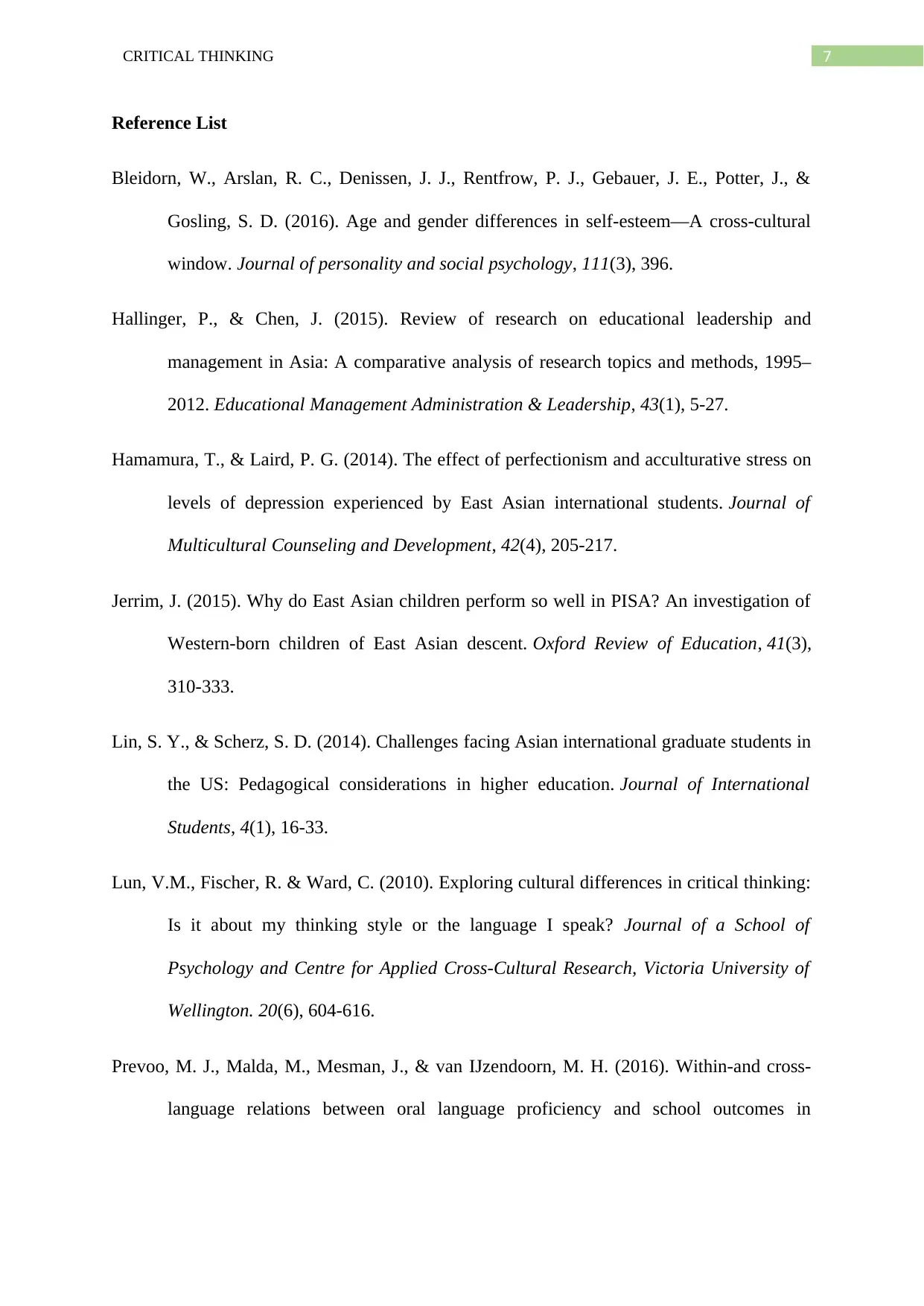
7CRITICAL THINKING
Reference List
Bleidorn, W., Arslan, R. C., Denissen, J. J., Rentfrow, P. J., Gebauer, J. E., Potter, J., &
Gosling, S. D. (2016). Age and gender differences in self-esteem—A cross-cultural
window. Journal of personality and social psychology, 111(3), 396.
Hallinger, P., & Chen, J. (2015). Review of research on educational leadership and
management in Asia: A comparative analysis of research topics and methods, 1995–
2012. Educational Management Administration & Leadership, 43(1), 5-27.
Hamamura, T., & Laird, P. G. (2014). The effect of perfectionism and acculturative stress on
levels of depression experienced by East Asian international students. Journal of
Multicultural Counseling and Development, 42(4), 205-217.
Jerrim, J. (2015). Why do East Asian children perform so well in PISA? An investigation of
Western-born children of East Asian descent. Oxford Review of Education, 41(3),
310-333.
Lin, S. Y., & Scherz, S. D. (2014). Challenges facing Asian international graduate students in
the US: Pedagogical considerations in higher education. Journal of International
Students, 4(1), 16-33.
Lun, V.M., Fischer, R. & Ward, C. (2010). Exploring cultural differences in critical thinking:
Is it about my thinking style or the language I speak? Journal of a School of
Psychology and Centre for Applied Cross-Cultural Research, Victoria University of
Wellington. 20(6), 604-616.
Prevoo, M. J., Malda, M., Mesman, J., & van IJzendoorn, M. H. (2016). Within-and cross-
language relations between oral language proficiency and school outcomes in
Reference List
Bleidorn, W., Arslan, R. C., Denissen, J. J., Rentfrow, P. J., Gebauer, J. E., Potter, J., &
Gosling, S. D. (2016). Age and gender differences in self-esteem—A cross-cultural
window. Journal of personality and social psychology, 111(3), 396.
Hallinger, P., & Chen, J. (2015). Review of research on educational leadership and
management in Asia: A comparative analysis of research topics and methods, 1995–
2012. Educational Management Administration & Leadership, 43(1), 5-27.
Hamamura, T., & Laird, P. G. (2014). The effect of perfectionism and acculturative stress on
levels of depression experienced by East Asian international students. Journal of
Multicultural Counseling and Development, 42(4), 205-217.
Jerrim, J. (2015). Why do East Asian children perform so well in PISA? An investigation of
Western-born children of East Asian descent. Oxford Review of Education, 41(3),
310-333.
Lin, S. Y., & Scherz, S. D. (2014). Challenges facing Asian international graduate students in
the US: Pedagogical considerations in higher education. Journal of International
Students, 4(1), 16-33.
Lun, V.M., Fischer, R. & Ward, C. (2010). Exploring cultural differences in critical thinking:
Is it about my thinking style or the language I speak? Journal of a School of
Psychology and Centre for Applied Cross-Cultural Research, Victoria University of
Wellington. 20(6), 604-616.
Prevoo, M. J., Malda, M., Mesman, J., & van IJzendoorn, M. H. (2016). Within-and cross-
language relations between oral language proficiency and school outcomes in
Paraphrase This Document
Need a fresh take? Get an instant paraphrase of this document with our AI Paraphraser
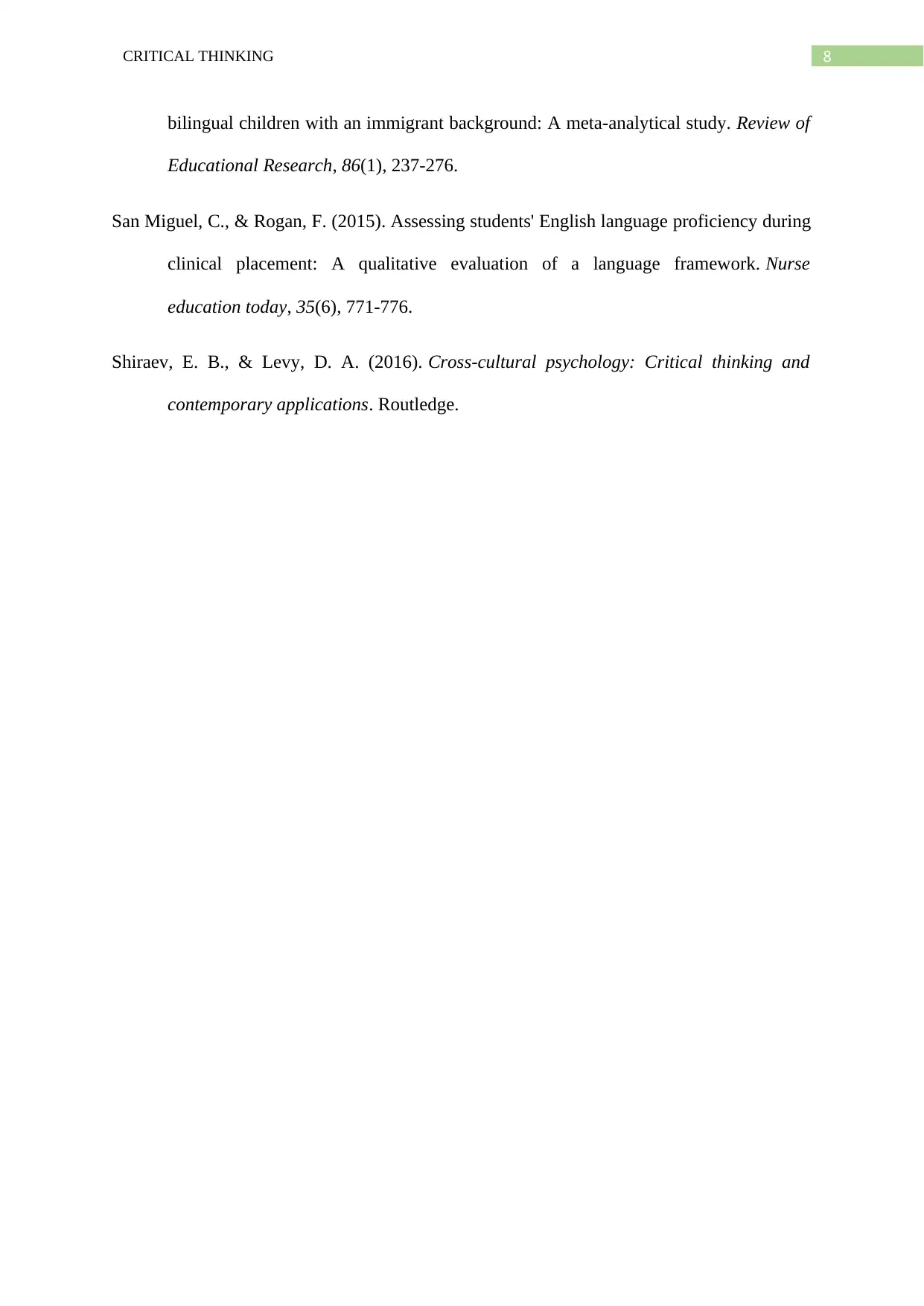
8CRITICAL THINKING
bilingual children with an immigrant background: A meta-analytical study. Review of
Educational Research, 86(1), 237-276.
San Miguel, C., & Rogan, F. (2015). Assessing students' English language proficiency during
clinical placement: A qualitative evaluation of a language framework. Nurse
education today, 35(6), 771-776.
Shiraev, E. B., & Levy, D. A. (2016). Cross-cultural psychology: Critical thinking and
contemporary applications. Routledge.
bilingual children with an immigrant background: A meta-analytical study. Review of
Educational Research, 86(1), 237-276.
San Miguel, C., & Rogan, F. (2015). Assessing students' English language proficiency during
clinical placement: A qualitative evaluation of a language framework. Nurse
education today, 35(6), 771-776.
Shiraev, E. B., & Levy, D. A. (2016). Cross-cultural psychology: Critical thinking and
contemporary applications. Routledge.
1 out of 8
Related Documents
Your All-in-One AI-Powered Toolkit for Academic Success.
+13062052269
info@desklib.com
Available 24*7 on WhatsApp / Email
![[object Object]](/_next/static/media/star-bottom.7253800d.svg)
Unlock your academic potential
Copyright © 2020–2025 A2Z Services. All Rights Reserved. Developed and managed by ZUCOL.





